CH01-Introduction to HRM
人力资源HRM英文对应
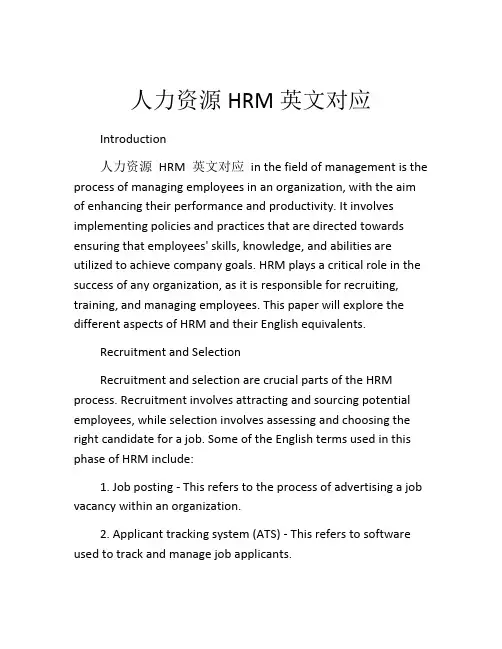
人力资源HRM英文对应Introduction人力资源HRM 英文对应in the field of management is the process of managing employees in an organization, with the aim of enhancing their performance and productivity. It involves implementing policies and practices that are directed towards ensuring that employees' skills, knowledge, and abilities are utilized to achieve company goals. HRM plays a critical role in the success of any organization, as it is responsible for recruiting, training, and managing employees. This paper will explore the different aspects of HRM and their English equivalents.Recruitment and SelectionRecruitment and selection are crucial parts of the HRM process. Recruitment involves attracting and sourcing potential employees, while selection involves assessing and choosing the right candidate for a job. Some of the English terms used in this phase of HRM include:1. Job posting - This refers to the process of advertising a job vacancy within an organization.2. Applicant tracking system (ATS) - This refers to software used to track and manage job applicants.3. Interview - This refers to the process of assessing and evaluating job applicants to determine their suitability.4. Selection criteria - This refers to the qualifications, experience, and other requirements that a candidate must possess to be considered for a job.Training and DevelopmentThe process of training and developing employees is essential for ensuring they have the necessary skills and knowledge to perform their jobs effectively. The following are some English terms used in this phase of HRM:1. On-the-job training - This refers to training an employee receives while performing their job.2. E-learning - This refers to training that is delivered online through a learning management system (LMS).3. Soft skills - These are interpersonal skills required for a job, such as communication, teamwork, and time management.4. Performance appraisal - This refers to the process of evaluating an employee's performance against pre-determined objectives and targets.CompensationCompensation is one of the critical aspects of HRM, as it involves the determination of salaries, bonuses, and benefits thatemployees receive for their services. The following are some English terms used in this phase of HRM:1. Wage - This refers to the hourly or daily rate that an employee earns.2. Salary - This refers to the amount of money an employee earns on an annual basis.3. Allowances - These are additional payments or perks that employees receive for their services, such as housing allowance, travel allowance, and medical insurance.4. Bonus - This refers to a special payment made to employees in addition to their regular salary or wage.Human Resource PlanningHuman resource planning involves forecasting the number and types of employees that an organization needs to achieve its objectives. The following are some English terms used in this phase of HRM:1. Workforce analysis - This refers to the process of analyzing an organization's current workforce to identify the skills and knowledge gaps that need to be filled.2. Talent management - This refers to the process of identifying, developing, and retaining key employees in an organization.3. Succession planning - This refers to the process of identifying potential successors for senior-level positions in an organization.4. Diversity and inclusion - These are policies and practices aimed at ensuring that employees from diverse backgrounds are treated fairly and equitably.ConclusionIn conclusion, the human resource management (HRM) process involves various aspects, including recruitment and selection, training and development, compensation, and human resource planning. These aspects are all critical to the success of an organization, and they require various English terms and concepts to convey their meaning effectively. Therefore, it is essential for HR professionals and managers to have a good understanding of the English equivalents of these concepts to operate effectively in increasingly globalized work environments.。
人力资源双语ch01 managing human resource today
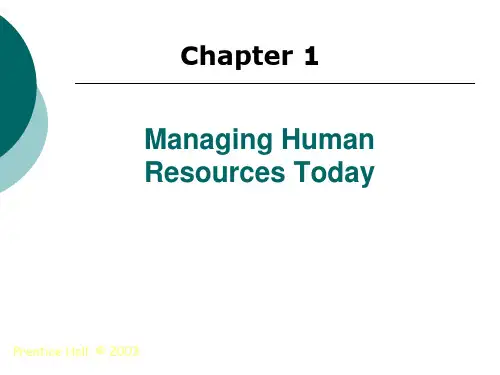
Prentice Hall, © 2003
HUMAN RESOURCE MANAGEMENT
Conducting job analyses (工作分析) Planning labor needs and recruiting job candidates (人员计划与招募) Selecting job candidates (人员甄选) Orienting (新人培训)and training Managing wages and salaries (薪酬管理)
Having your company taken to court because of your illegal actions
Prentice Hall, © 2003
Take our 20 best people away, and I will tell you that Microsoft would become an unimportant company -----------Bill Gates
refer to the tendency of firms to extend their sales, ownership, and/or manufacturing to new markets abroad More Globalization means more competition
Prentice Hall, © 2003
Cooperative Line and Staff HR Management
Which HR management activities are carried out by line managers and by staff managers? There is no final answer. HR management is an integral part of every manager’s job.
人力资源管理01_What is HRM
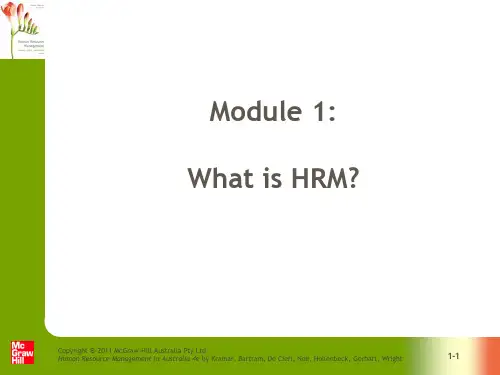
Copyright 2011 McGraw-Hill Australia Pty Ltd Human Resource Management in Australia 4e by Kramar, Bartram, De Cieri, Noe, Hollenbeck, Gerhart, Wright
• Humanistic (Soft)
– Recognises the need for integration of policies but emphasises employee development, collaboration, participation, trust and informed choice.
1-2
Human re Refers to the policies, practices and systems that influence employees’ behaviour, attitudes and performance. • Many companies refer to HRM as ‘people management practices’. • The focus is on managing people within the employer–employee relationship.
Copyright 2011 McGraw-Hill Australia Pty Ltd Human Resource Management in Australia 4e by Kramar, Bartram, De Cieri, Noe, Hollenbeck, Gerhart, Wright
hrm excercise 01 Introduction to HRM
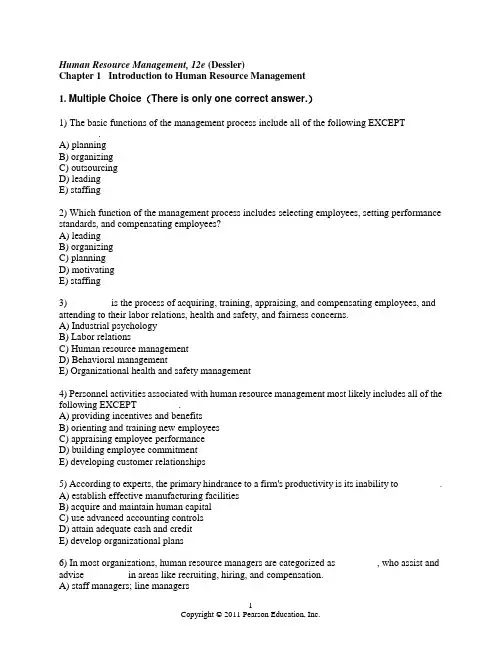
Human Resource Management, 12e (Dessler)Chapter 1 Introduction to Human Resource Management1. Multiple Choice(There is only one correct answer.)1) The basic functions of the management process include all of the following EXCEPT________.A) planningB) organizingC) outsourcingD) leadingE) staffing2) Which function of the management process includes selecting employees, setting performance standards, and compensating employees?A) leadingB) organizingC) planningD) motivatingE) staffing3) ________ is the process of acquiring, training, appraising, and compensating employees, and attending to their labor relations, health and safety, and fairness concerns.A) Industrial psychologyB) Labor relationsC) Human resource managementD) Behavioral managementE) Organizational health and safety management4) Personnel activities associated with human resource management most likely includes all of the following EXCEPT ________.A) providing incentives and benefitsB) orienting and training new employeesC) appraising employee performanceD) building employee commitmentE) developing customer relationships5) According to experts, the primary hindrance to a firm's productivity is its inability to ________.A) establish effective manufacturing facilitiesB) acquire and maintain human capitalC) use advanced accounting controlsD) attain adequate cash and creditE) develop organizational plans6) In most organizations, human resource managers are categorized as ________, who assist and advise ________ in areas like recruiting, hiring, and compensation.A) staff managers; line managersB) line managers; middle managersC) line managers; staff managersD) compensation managers; line managersE) functional managers; staff managers7) Which of the following has historically been an integral part of every line manager's duties?A) responding to customer complaintsB) developing budgetary guidelinesC) handling personnel issuesD) creating personnel policiesE) establishing dress codes8) A line manager's human resource responsibilities most likely include all of the following EXCEPT ________.A) maintaining department moraleB) training employees in new positionsC) controlling labor costsD) protecting employees' healthE) marketing new products and services9) Which of the following is most likely NOT a function of the human resource manager?A) directing personnel activities within the HR departmentB) ensuring that line managers are implementing HR policiesC) advising line managers about how to implement labor lawsD) representing the interests of employees to senior managementE) integrating the duties of line managers with staff managers10) All of the following are ways in which an HR manager most likely assists and advises line managers EXCEPT ________.A) ensuring compliance with occupational safety lawsB) administering health and accident insurance programsC) representing employees' interests to upper managementD) making strategic business planning decisionsE) hiring, training, and evaluating employees11) All of the following are examples of human resource specialties EXCEPT ________.A) recruiterB) job analystC) financial advisorD) compensation managerE) labor relations specialist12) In general, how many human resource employees would be on staff for a firm with 500 total employees?A) 1 B) 2 C) 5 D) 10 E) 2013) In most firms, line managers work in conjunction with HR managers when ________.A) visiting college campuses to recruitB) interviewing job applicantsC) administering preemployment testsD) filing benefits informationE) testing employees for drugs14) What term refers to the knowledge, education, training, skills, and expertise of a firm's workers?A) human resourcesB) human capitalC) intangible assetsD) contingent personnelE) intellectual property15) Strategic human resource management refers to ________.A) formulating and executing human resource policies and practices that produce the employee competencies and behaviors the company needs to achieve strategic aimsB) planning the balance of internal strengths and weaknesses with external opportunities and threats to maintain competitive advantageC) emphasizing the knowledge, education, training, skills, and expertise of a firm's workersD) extending a firm's sales, ownership, and manufacturing to new marketsE) managing a firm's insurance benefits administration process2.True or False1) Communicating is one of the five basic functions of the management process.2) Hiring the wrong person for the job, committing unfair labor practices, and failing to motivate employees are personnel mistakes that hinder firms from achieving positive results.3) Staff managers are authorized to issue orders to subordinates and are directly in charge of accomplishing the organization's basic goals.4) Human resource managers assist line managers with hiring, training, evaluating, rewarding, counseling, promoting, and hiring employees.5) Strategic human resource management refers to performing transactional duties that satisfy the needs and demands of both the employees and the employer.3. Please discuss the following question (You are allowed to answer the followi ng questions in Chinese).Why is human resource management important to all managers? What is the role of line managers in human resource management?。
Introduction to HRM
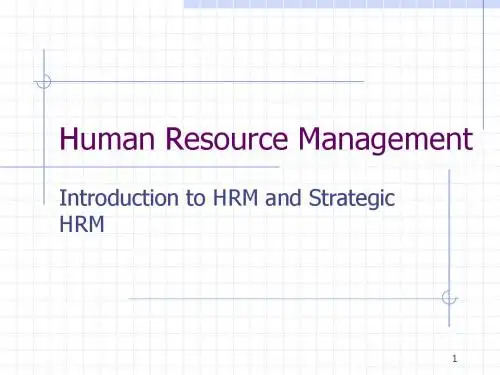
5
Strategic Importance of HRM
Planning
Using models that include realistic, challenging, specific, and meaningful goals. Preparing reports on HRM solutions to problems encountered by the firm. Emphasizing the strategic importance of HRM and the importance of contributing to the firm‟s profits.
Reporting
Training
6
Strategic Importance of HRM
“to influence the hearts and minds of our people…so they care more about our business than competitors care about theirs.”
Costs or benefits of such HRM issues as:
productivity, salaries and benefits, recruitment, training, absenteeism, overseas relocation, layoffs, meetings, and attitude surveys.
Human Resource Management
Introduction to HRM and Strategic HRM
1
What Is HRM?
卡特洗衣公司案例分析答案超全

卡特洗衣公司案例分析答案超全(总38页)--本页仅作为文档封面,使用时请直接删除即可----内页可以根据需求调整合适字体及大小--Continuing report of HRM (The Hotel Paris International)院系:班级:人力学号:姓名:课程名称:人力资源管理完成时间:年月至年月ContentCHAPTER 1 INTRODUCTION TO HUMAN RESOURCE MANAGEMENT .......... 错误!未定义书签。
CHAPTER 3 HUMAN RESOURCE MANAGEMENT STRATEGY AND ANALYSIS .... 错误!未定义书签。
CHAPTER 4 JOB ANALYSIS AND THE TALENT MANAGEMENT PROCESS ..... 错误!未定义书签。
CHAPTER 5 PERSONNEL PLANNING AND RECRUTING ................... 错误!未定义书签。
CHAPTER 6 EMPLOYEE TESTING AND SELECTION ..................... 错误!未定义书签。
CHAPTER 7 INTERVIEWING CANDIDATES ............................ 错误!未定义书签。
CHAPTER 8 TRAINING AND DEVELOPING EMPLOYEES .................. 错误!未定义书签。
CHCAPTER 9 PERFORMANCE MANAGEMENT AND APPRAISAL .............. 错误!未定义书签。
CHAPTER 10 MANAGING EMPLOYEE RETENTION, ENGAGEMENT, AND CAREERS错误!未定义书签。
self-introduction
Hello, everyone! I am very glad to introduce myself to you. My name is Zhongyiling,and I am from the city of GuangZhou in Guangdong province.大家好!很高兴向大家做自我介绍。
我叫钟薏铃来自广东省广州市。
Now I major in HRM department in Guangdong university of finance and economics.现在我在广东财经大学主修人力资源管理这一专业。
I like my major because I think be a hr maybe I can make many friends from different city and then learn different culture.我喜欢这一专业是因为我觉得作为一个hr,我会交到很多的朋友并且可以通过他们了解到不同地方的文化。
And I am a foodie. I like enjoying different kind of cates, especially, seafood.我还是一个吃货,我喜欢各种各样的美食,尤其是海鲜。
So I always go to find the characteristic snack with my friends around my college at weekends.所以我和我的朋友经常在周末跑出去寻找各种特色小吃。
After class I play with my friends and sometimes we go out to visit scenic spots around Guangzhou,课余时间我一般都是和朋友在一起,有时候我们会去参观广州周围的旅游景点。
By this way ,I can enjoy my life very well.我很享受这样的生活。
人力资源知识-HRM专业英语 精品
Managing performance
Appraising performance
Compensation, incentives and benefits Employee safety and health Labor relations
• Unit 6 Performance and Career Management
– Section A: Performance Appraisal – Section B: Career Management
• Unit 7 Compensation, incentives and benefits
• Unit 3 HR Planning and Recruitment
– Section A: Employment Planning and Forecasting – Section B: Recruiting Job Candidates
• Unit 4 Selection and Interviewing
Section A
1
Definition of Human Resource
Management
2
Functions of HRM
3
Roles of HR department
➢“All managers are HR managers.”
Human Resource
the individuals who make up the workforce of an organization
Staff manager
人力资源管理Ch1_introduction_Multiple Choice
Chapter 1:Multiple ChoiceThe primary function of managing is: 1.maximizing profits.managing budgets.getting results through people.leading employees.The management process includes: 2.planning, staffing, and leading.organizing, controlling, and budgeting.staffing, leading, and motivating.planning, leading, and motivating.3.Setting quality and production standards is a function of:leading.controlling.managing.evaluating.4. Attending to employees' health and safety concerns is a part of the ___________ function.SupervisoryHuman Resource ManagementOccupational Safety and HealthCounseling5.Motivating, appraising and developing employees contributes to:a successful manager.good personnel policies.avoiding hiring mistakes.high profit levels.6. Recruiting, interviewing and selecting employees are the responsibility of:human resources managers.staff personnel.the line and staff managers.the human resources department.7. _________ are in charge of accomplishing the organization's basic goals.Company executivesLine managersStaff and line managersProduction employees8. Making decisions, directing others and giving orders are the rights bestowed by:management.authority.the HR department.all managers.A Human Resources Manager exerts:9.staff authority and line authority.implied authority.hiring authority.Line authority and control authority.Access to top management gives human resources _____ authority.10.LineStaffManagementImplied11.Human resources managers perform staff functions by:hiring, promoting, firing employees.assisting and advising line managers.advising top management.implementing policies and procedures.12. Establishing qualifications needed by employees in specific positions are the responsibility of:human resources managers.top management.line managers.staff manager.13. Maintaining a competitive advantage is a goal of the company's strategic plan,and is to make decision about portfolio of businesses comprising organization and relationships among them .profit level.business level strategy. internal strengths. corporate level strategy.14. Building and strengthening a company's long-term competitive position is a function of its:corporate strategy.functional strategy.business-level strategy.competitive advantage.16. Respond to new challenges , new models of organizing and managing included:pyramid-shaped organizationEmployees have little power to make more and more decisions Managers will not “manage”highly structured organization.17.The nature of work is changing as the result of:increased competition.technology.deregulation.globalization.18. New human resources management methods, and knowledge workers are required by the shift of:manufacturing jobs to service jobs.manufacturing jobs overseas.manufacturing jobs to clerical jobs.goods-producing industries to military management models.19.Downsizing workforces and merging with other firms are efforts to:expand operations.improve competitiveness.achieve diversity. expand globally.20. Organizational changes driven by global expansion and improved competitiveness are:increasing managers' power bases.increasing the use of power.altering the bases of power.diluting the effects of power.21.Globalized firms achieve competitive advantage by improving their:financial capital.human capital.power basesstrategic plans.22. Developing organizational cultures that foster innovation and flexibility is a function of:diversity.globalization.employee commitment.strategic human resources management.23.A firm's competitive strategies should be supported by its:functional strategies.diversity strategies.corporate-level strategies.business strategies.24. At the heart of HR's strategic role is the __________ of the firm's strategies.CommitmentExecutionPlanningDocumenting。
Ch_01-2 Introduction to Macroeconomics
• For an economy as a whole, income must equal expenditure because:
– 作为一个经济总体,收入必须等于支出,因为:
• Every transaction has a buyer and a seller.
Accounting of Macroeconomy
Chapter 01
Macroeconomics
• 现在我们习以为常的一些东西,实际上历史都不长。 • 一般认为,凯恩斯的《通论》是宏观经济学诞生的 标志。凯恩斯的著作、其他经济学家对这部著作的 解释和批评,形成了我们现在所谓的宏观经济学和 宏观经济政策。 • 微观经济学和宏观经济学不可分割。当我们研究整 个经济时,我们必须考虑个别经济参与者的决策。 • 宏观经济理论是建立在微观经济基础之上的。 • 但是,宏观经济学也在以下几方面区别于微观经济 学:
Great Depression
10,000
Second oil price shock World War II
0 1900 1910 1920 1930 1940 1950 1960 1970 1980 1990 2000
Why learn Macroeconomics?
为何学习宏观经济学?
1.
3. The macroeconomy affects politics & current events.
宏观经济影响政治和社会生活 example: Inflation and unemployment in election years
Inflation and Unemployment in Election Years 选举年的通胀和失业
- 1、下载文档前请自行甄别文档内容的完整性,平台不提供额外的编辑、内容补充、找答案等附加服务。
- 2、"仅部分预览"的文档,不可在线预览部分如存在完整性等问题,可反馈申请退款(可完整预览的文档不适用该条件!)。
- 3、如文档侵犯您的权益,请联系客服反馈,我们会尽快为您处理(人工客服工作时间:9:00-18:30)。
5
Strategic Importance of HRM
Planning
Using models that include realistic, challenging, specific, and meaningful goals. Preparing reports on HRM solutions to problems encountered by the firm. Emphasizing the strategic importance of HRM and the importance of contributing to the firm‟s profits.
3
Brief History
The Industrial Revolution and the onset of Personnel Departments
The „gap‟ between owners and workers.
Frederick W. Taylor – father of scientific management – improving worker efficiency. Development of „Industrial Psychology‟ – focused on the „well-being‟ of the worker. Development of „Organizational Behavior‟ – importance of social interaction and the work group.
“Whenever you fire someone, you put the competition in
business.”
11
Objectives of HRM Function
Helping the organization reach its goals Efficiently employing the skills and abilities of the workforce Providing well-trained and wellmotivated employees Increasing employees‟ job satisfaction and self-actualization Achieving quality of work life
Human Resource Management
Introduction to HRM and Strategic HRM
1
What Is HRM?
Human resource management is the function performed in organizations that facilitates the most effective use of people (employees) to achieve organizational and individual goals.
Costs or benefits of such HRM issues as:
productivity, salaries and benefits, recruitment, training, absenteeism, overseas relocation, layoffs, meetings, and attitude surveys.
10
HRM and the Competitive Environment
What are the costs of employee turnover?
Severance pay for the former worker. Costs of recruiting a replacement. Costs of training a new replacement. Impact on remaining employees. Concerns of existing customers. Competitor‟s gain an advantage.
14
End ofes of HRM Function
Communicating HRM policies to all employees Maintaining ethical policies and Socially Responsible Behavior Managing change Improving productivity
– Richard Kovacevich, CEO of Norwest
7
HRM and Organizational Effectiveness
Requirements for organizational effectiveness. Mission and strategy. Organizational structure. Policy vs. Personality. HRM. People are the most important asset of any organization.
13
Who Performs HRM Activities
HR Specialists vs. Operating Managers Line authority vs. Staff authority When is it economically viable to have HRM? What portion of an Operating Manager‟s time spent doing HR functions? Describe potential conflicts between HRM and Operating Managers.
“There are no bargains when it comes to people.”
8
HRM and Organizational Effectiveness
HRM criteria for Organizational Effectiveness Performance Legal compliance Employee satisfaction Absenteeism Turnover Training effectiveness Return on investment Grievance rates Accident rates
4
Strategic Importance of HRM
Problem Solving
Assessment
Analyzing and solving problems from a profit-oriented, not just a service-oriented point of view.
2
HRM Activities
Equal employment opportunity (EEO) compliance Job Analysis Human resource planning Employee recruitment, selection, motivation, and orientation Performance evaluation and compensation Training and Development Labor Relations Safety, health, and wellness
Reporting
Training
6
Strategic Importance of HRM
“to influence the hearts and minds of our people…so they care more about our business than competitors care about theirs.”
9
HRM and the Competitive Environment
How can effective HRM improve a firm‟s competitiveness? Happier employees means higher productivity (i.e. more profitable). Employees who are treated respectfully are more loyal (i.e. lower turnover). Employees who feel their opinions are valued are more likely to feel important (i.e. more responsible).
